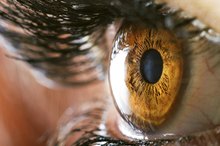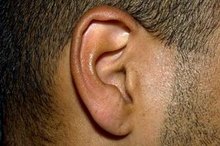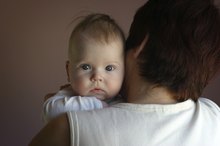A Crease in an Infant's Ear
Diagonal ear creases can have significant implications for adults. Infants are different, however — their bodies are still developing and such a crease might be little more than a wrinkle. That does not mean you should ignore creases in a baby's ears, however, as it might still be a sign of a problem. Ear creases should be evaluated by your child's doctor to rule out a congenital heart problem known as Beckwith-Wiedemann syndrome 2.
If you are experiencing serious medical symptoms, seek emergency treatment immediately.
Ear Anatomy
The outside of the ear — also called the pinna or flap — is made primarily of cartilage, a connective tissue that is both rigid and flexible. This is just one part of the overall system that allows your baby to hear sounds. The job of the pinna is to help determine the location of noise, according to Indiana University. Creases in the outside of the ear generally mean a diagonal groove that forms between the flap portion and the lobe. For children, this crease is insignificant most of the time.
- The outside of the ear — also called the pinna or flap — is made primarily of cartilage, a connective tissue that is both rigid and flexible.
- Creases in the outside of the ear generally mean a diagonal groove that forms between the flap portion and the lobe.
Wrinkles
What Causes Protruding Ears?
Learn More
Infants spend a lot of time sleeping. Depending on the location of the crease, it may just be due to the way the baby lays her head. If the ridge forms more on one side than the other, chances are the flap or lobe folds when your child is resting, and a crease is an impression or wrinkle. Cartilage is extremely flexible. If the crease fades away after a while, it probably means nothing and is not a sign of a medical problem. The creases may also be a genetic feature of the ears.
- Infants spend a lot of time sleeping.
- Depending on the location of the crease, it may just be due to the way the baby lays her head.
Beckwith-Wiedemann Syndrome
For some infants, an ear crease is one of the many symptoms of a congenital heart condition known as Beckwith-Wiedermann syndrome 2. This is a medical problem that develops in utero and, in most cases, would be detected at birth. Other signs of Beckwith-Wiedermann syndrome include enlargement of organs, eyes and body 2. Babies with this condition tend to have low blood sugar and poor feeding ability. Beckwith-Wiedermann can be fatal, but once a child survives infancy the prognosis improves.
Cardiac Disease
Warning Signs and Symptoms of a Dangerous Sinus Infection
Learn More
While earlobe creases mean little for infants, they may be a significant indicator in adults, although studies have yet to prove a connection 1. It is possible that diagonal ear creases in an adult is a be a sign of heart disease, reports the University of Maryland Medical Center. Some research suggests that the correlation is simply age. As you grow older, you may develop creases in the lobes and heart disease, but the two are not connected. Creases for babies do not raise the same concern, because cardiac disease is not a common problem during infancy.
- While earlobe creases mean little for infants, they may be a significant indicator in adults, although studies have yet to prove a connection 1.
- Creases for babies do not raise the same concern, because cardiac disease is not a common problem during infancy.
Related Articles
References
Writer Bio
Writing since 1999, Darla Ferrara is an award-winning author who specializes in health, diet, fitness and computer technology. She has been published in "Mezzo Magazine" and Diet Spotlight, as well as various online magazines. Ferrara studied biology and emergency medical technology at the University of Nebraska and Southeast Community College.





